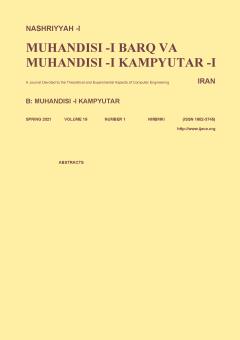Construction of Scalable Decision Tree Based on Fast Data Partitioning and Pre-Pruning
Subject Areas : electrical and computer engineering
سميه لطفي
1
,
Mohammad Ghasemzadeh
2
![]() ,
Mehran Mohsenzadeh
3
,
Mitra Mirzarezaee
4
,
Mehran Mohsenzadeh
3
,
Mitra Mirzarezaee
4
1 -
2 - Yazd University
3 -
4 -
Keywords: Pre-pruning, data mining, decision tree, scalable,
Abstract :
Classification is one of the most important tasks in data mining and machine learning; and the decision tree, as one of the most widely used classification algorithms, has the advantage of simplicity and the ability to interpret results more easily. But when dealing with huge amounts of data, the obtained decision tree would grow in size and complexity, and therefore require excessive running time. Almost all of the tree-construction algorithms need to store all or part of the training data set; but those algorithms which do not face memory shortages because of selecting a subset of data, can save the extra time for data selection. In order to select the best feature to create a branch in the tree, a lot of calculations are required. In this paper we presents an incremental scalable approach based on fast partitioning and pruning; The proposed algorithm builds the decision tree via using the entire training data set but it doesn't require to store the whole data in the main memory. The pre-pruning method has also been used to reduce the complexity of the tree. The experimental results on the UCI data set show that the proposed algorithm, in addition to preserving the competitive accuracy and construction time, could conquer the mentioned disadvantages of former methods.
[1] S. Agarwal, "Data mining: data mining concepts and techniques," in Proc. IEEE Int. Conf. on Machine Intelligence and Research Advancement, . pp. 203-207, Katra, India, 21-23 Dec. 2013.
[2] S. B. Kotsiantis, "Decision trees: a recent overview," Artificial Intelligence Review, vol. 39, no. 4, pp. 261-283, 2013.
[3] Z. Ruiz, J. Salvador, and J. Garcia-Rodriguez, "A survey of machine learning methods for big data," in International Work-Conf. on the Interplay Between Natural and Artificial Computation, pp. 259-267, Springer, Cham, Jun. 2017.
[4] S. Lomax and S. Vadera, "A survey of cost-sensitive decision tree induction algorithms," ACM Computing Surveys (CSUR), vol. 45, no. 2, pp. 1-35, Feb. 2013.
[5] Y. L. Chen, C. C. Wu, and K. Tang, "Time-constrained cost-sensitive decision tree induction," Information Sciences, vol. 354, pp. 140-152, Mar. 2016.
[6] F. Stahl and M. Bramer, "Jmax-pruning: a facility for the information theoretic pruning of modular classification rules," Knowledge-Based Systems, vol. 29, pp. 12-19, 2012.
[7] S. Hwang, H. G. Yeo, and J. S. Hong, "A new splitting criterion for better interpretable trees," IEEE Access, vol. 8, pp. 62762-62774, 2020.
[8] J. Gehrke, V. Ganti, R. Ramakrishnan, and W. Y. Loh, "BOAT-optimistic decision tree construction," ACM SIGMOD Record, vol. 28, no. 2, pp. 169-180, Jun. 1999.
[9] M. Mehta, R. Agrawal, and J. Rissanen, "SLIQ: a fast scalable classifier for data mining," Advances in Database Technology-EDBT'96, pp. 18-32, 1996.
[10] J. Shafer, R. Agrawal, and M. Mehta, "SPRINT: a scalable parallel classifier for data mining," in Proc. Int. Conf. Very Large Data Bases, vol. 96, pp. 544-555, 3-6 Sept. 1996.
[11] J. Gehrke, R. Ramakrishnan, and V. Ganti, "Rainforest-a framework for fast decision tree construction of large datasets," Data Mining and Knowledge Discovery, vol. 4, pp. 127-162, 2000.
[12] G. Hulten and P. Domingos, "Mining decision trees from streams," in Garofalakis M., Gehrke J., Rastogi R. (eds.) Data Stream Management. Data-Centric Systems and Applications. pp. 189-208, Springer Berlin Heidelberg, 2016.
[13] C. C. Wu, Y. L. Chen, Y. H. Liu, and X. Y. Yang, "Decision tree induction with a constrained number of leaf nodes," Applied Intelligence, vol. 45, no. 3, pp. 673-685, Oct. 2016.
[14] A. Franco-Arcega, J. A. Carrasco-Ochoa, G. Sanchez-Diaz, and J. F. Martinez-Trinidad, "Decision tree induction using a fast splitting attribute selection for large datasets," Expert Systems with Applications, vol. 38, no. 11, pp. 14290-14300, Oct. 2011.
[15] B. Chandra, R. Kothari, and P. Paul, "A new node splitting measure for decision tree construction," Pattern Recognition, vol. 43, no. 8, pp. 2725-2731, Aug. 2010.
[16] P. S. Akash, M. E. Kadir, A. A. Ali, and M. Shoyaib, "Inter-node hellinger distance based decision tree," in Proc. 28th Int. Joint Conf. on Artificial Intelligence, IJCAI’19, pp. 1967-1973, Aug. 2019.
[17] M. Bramer, "Using J-pruning to reduce overfitting in classification trees," Knowledge-Based Systems, vol. 15, no. 5, pp. 301-308, Jul. 2002.


